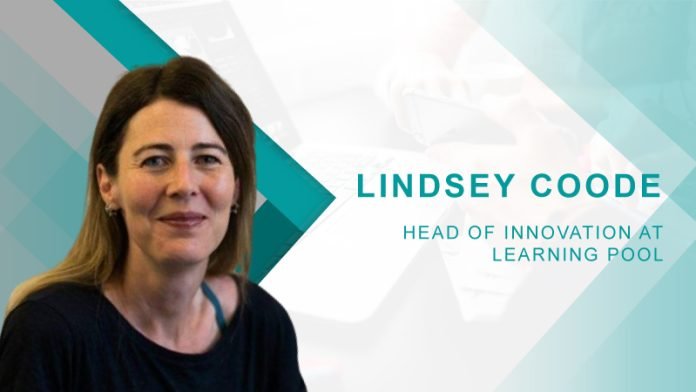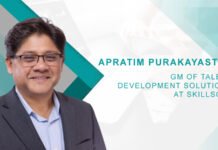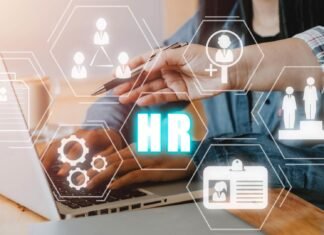Lindsey, can you briefly introduce yourself and tell us about your role as Head of Innovation at Learning Pool?
I’ve been in the learning technologies industry for over 20 years. It all started with an engineering degree and a university project, and I’ve been involved ever since. The majority of my experience is grounded in grounded in designing learning content with an emphasis on evidence-based learning theory.
My role at Learning Pool involves looking at the future of learning technologies—three to five years in the future—and considering the challenges for organizations and how we at Learning Pool might approach finding solutions to those in the short-to-mid term.
When I don’t have my learning technologies hat on, you can find me in the great outdoors, trail running, hiking or out on my bike.
How did you become involved in the field of workplace learning, and what motivated you to specialise in this area?
I had a slightly odd route – as do many in learning technologies. My journey all started when I was at university. I was working toward a mechanical engineering degree, but I knew that wasn’t what I wanted to do for a living. After a conversation with my tutor, they suggested I take on e-learning for the mechanical engineering faculty. So I did! I researched how people learn and ended up building a program. Back then, it was an arduous process to build a learning software like that.
That’s how it all started. After university, I began looking for a job as a learning designer. That’s what I’ve focused on for a huge part of my career – building content and learning materials. In the last five years, I’ve moved more into the product side of learning technology, where I think about how people learn and how we can make products that really impact the performance of organizations and their people.
Evolution of Workplace Learning
What significant changes have you observed in the evolution of workplace learning over the years?
For a long time, not much had changed fundamentally in workplace learning. Perhaps the medium changed – from a CD Rom to browser-based, video streaming, but the ways people were using learning technologies was very similar.
There’s been a shift in the last five to 10 years that’s put the emphasis on the learner versus administrator. It’s a less tick-the-box exercise and thinking about how we can improve people’s performance and, ultimately, development. In the last couple of years, the onus has evolved further to how we can retain our best people; learning technologies is a means of doing that. The result is that you’re helping employees learn for their own benefit—and the benefit of the organization—while also helping the individual progress their career within the organization.
Can you share any specific challenges organisations faced during this evolution?
There are always hardware issues with rollouts of new technology. For example, there’s recent buzz around VR headsets in learning. The reality is it can be an uphill battle to get these devices—and the downloaded learning content—to the people who need them.
The bigger, and arguably more important, challenge is getting those throughout the organization to think holistically about learning and development. Too many think that one course will solve a gap. But we need to think bigger than that: Organizations must think about the big picture and all that surrounds the individual or teams where improvement is needed. L&D has the power to fundamentally transform organizations and their people for the better, leading to greater business results and a competitive advantage.
Part of this challenge comes from the fact that, historically, learning and development was hard to measure. Outside of course completion rates, it’s difficult to demonstrate the value. It’s hard to say because someone took Course A, we therefore saw X change in business KPIs. You need contextual data based on the individual that reveals their strengths and areas to improve. At Learning Pool, for example, intelligent data powers our learner experience. Knowing that kind of data is on hand, you can better establish a course of action and measure against that goal of impact.
Getting Staff Engaged and Retained
What strategies or innovations have you seen that organisations are using to keep their staff engaged and retained through learning initiatives?
Forward-thinking organizations have started to put learners in charge of their own destiny. It all comes down to recognizing the skills, abilities, interests, etc. of the individual. Just because someone is on a particular team doesn’t mean that’s where they want to end up – sometimes, it is just an open job. Understanding where your people want to go, and their transferable skills is how you impact engagement and retention. That enables you to introduce opportunities for movement throughout the organization so people constantly feel challenged, seen and engaged.
Could you provide examples of successful employee engagement and retention practices in workplace learning?
Right now, there’s a lot of talk in the learning technologies community about skills in general. Learning Pool has a great skills platform that’s easy for learners to build their skills profile effectively and then use it to match with other people, roles or opportunities across the business. That level of visibility into the skills you’ve got and the skills your people need is key for the organization. It breaks silos between teams and opens the playing field for development no matter what team or project you’re on.
Traditionally, this type of “assessment” is left up to the manager. But they’re often too busy with their own day-to-day to sit down and understand the skills profile of everyone on their team – or have the awareness of better-fitting opportunities elsewhere. That’s where a resource like Learning Pool can help.
Generative AI in Workplace Learning
According to you, how is generative AI impacting workplace learning, and what role does it play in enhancing the learning experience for employees?
Generative AI represents a big shift that’s allowing us to find solutions to age-old problems. Let’s take difficult or complex conversations between managers and their teams and offering a way to practice. It’s been nearly impossible to simulate real-life experiences at scale AND provide personalized feedback to improve. We’ve tried branching scenarios, but these aren’t very realistic. We’ve tried face-to-face with other employees or actors, but these aren’t scalable.
Up until now, a lot of management training was based on modelling the behaviour around you. It’s sort of like children – we learn by example. That means if you’ve had a great manager, you see and can model that behaviour into your own management style. But if you’re new to the management world and haven’t had the modelled behaviour to go off of, it’s tough to craft your management approach. We have an offering at Learning Pool called AI Conversations, which solves for all of this. AI Conversations leverages GenAI to simulate a realistic conversation with an “AI employee” and then provides constructive feedback to improve. The manager can practice as many times as needed to feel confidently prepared.
What innovative ways are organisations using generative AI to create personalised learning experiences?
Generative AI pushes the boundaries on assessing mastery. We’re at a point where we can assess an open response question really well. In our learning courses, we’ve always had open inputs. Unfortunately, a lot of people will write the bare minimum until they’re allowed to hit the submit button. But with GenAI, we can personalize the feedback, so we can put a framework behind that open input that would say something like: You’ve said XYZ, and that’s great. But you didn’t mention ABC, and it’s worth taking a look at the following program. The GenAI here is almost like a personal tutor to guide the learner on their journey.
Challenges and Solutions
What are some of the common challenges organisations encounter when implementing learning initiatives, and how can they address these effectively?
Specifically around GenAI, because it’s an entirely new kind of technology, it’s easy for L&D professionals to feel slightly nervous, and the approach to it varies across organizations. It’s important for L&D to know what kind of questions to ask: What AI are you using? What happens to the data? Is our entered data being used to train models?
Once L&D has a better understanding of what the challenges might be, they can feel prepared when they’re asked at a higher level during a procurement process. Partnering with a trusted learning technologies provider like Learning Pool can help L&D on this journey to getting the most out of AI in an effective, compliant way.
In your experience, what advice would you give to organisations looking to optimise their learning programs to ensure employee engagement and retention?
Variety is key. People want different experiences, and they want learning that fits into their existing workflows. Digital adoption platforms helps ensure learning in the workflow.
At a higher level, I can’t emphasize enough the importance of a culture of learning. Work hard to create an environment where people aren’t afraid to ask questions or ask for help on a particular topic. It’s up to L&D to take it a step further. Instead of just creating a course, think broadly about how you can help that individual make that journey. Is there someone else in the organization doing this well that can be a model? Or is there an existing e-learning course that could be helpful?
It’s so important to have a real variety of different ways for people to build their own understanding knowledge, skills and behaviour.
Future Trends
What emerging trends do you foresee in the field of workplace learning, and how can organisations stay ahead of the curve?
It’s all about personalization. We’re in a state now where we’re massively overwhelmed by the amount of content. Creating more content, whether it’s podcasts, traditional e-learning or articles, isn’t the answer. There is plenty of information out there. It’s making that information relevant to individuals and easy to find.
One of the ways that that might happen is through GenAI coaches that take you on a journey. We’re currently testing how to use GenAI to create an online coach. It asks you your ambitions, what you’re doing currently, what you’re struggling with, and what’s stopping you from reaching your goals. It then takes all that information and guides you through how to reach them – whether that’s learning, a recommended mentor within your organization, etc. Imagine how powerful that would be.
Final Thoughts
If you could offer one piece of advice to HR and L&D professionals to excel in creating engaging and effective learning experiences, what would it be?
Storytelling, storytelling, storytelling! Make sure anything you create takes people on a journey. It’s easy to offer six steps to better communication. But unless you practice it or really consider what could go right and what could go wrong and put a story around that, then it’s not particularly impactful. Someone would likely read the six tips, find them helpful in the moment, and then instantly forget them when a situation arises.
Active learning based on scenarios engages and pulls people in. It’s the reason we all watch films and dramas. People like to be submerged in it, and learning is no different.
Explore HRtech News for the latest Tech Trends in Human Resources Technology.

Lindsey Coode Head of Innovation at Learning Pool
Lindsey is the head of innovation at Learning Pool – with over 25 years of experience in designing and managing learning technology projects. Starting out as a learning designer, she is passionate about designing impactful learning experiences.












